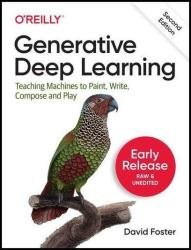Generative Deep Learning: Teaching Machines to Paint, Write, Compose, and Play, 2nd Edition (5th Early Release)
- Добавил: literator
- Дата: 18-11-2022, 01:04
- Комментариев: 0
 Название: Generative Deep Learning: Teaching Machines to Paint, Write, Compose, and Play, 2nd Edition (5th Early Release)
Название: Generative Deep Learning: Teaching Machines to Paint, Write, Compose, and Play, 2nd Edition (5th Early Release)Автор: David Foster
Издательство: O’Reilly Media, Inc.
Год: 2022-11-16
Страниц: 286
Язык: английский
Формат: epub
Размер: 42.6 MB
Generative modeling is one of the hottest topics in AI. It is now possible to teach a machine to excel at human endeavors such as painting, writing, and composing music. With this practical book, Machine Learning engineers and data scientists will discover how to re-create some of the most impressive examples of generative Deep Learning models such as variational autoencoders, generative adversarial networks (GANs), Transformers, normalizing flows, and diffusion models.
A generative model can be broadly defined as follows:
Generative modeling is a branch of Machine Learning (ML) that deals with the creation of models that can generate new data points that are similar to the training data.
What does this mean in practice? Suppose we have a dataset containing images of horses. We may wish to build a model that can generate a new image of a horse that has never existed but still looks real because the model has learned the general rules that govern the appearance of a horse. This is the kind of problem that can be solved using generative modeling.
In order to truly understand what generative modeling aims to achieve and why this is important, it is useful to compare it to its counterpart, discriminative modeling. If you have studied Machine Learning, most problems you will have faced will have most likely been discriminative in nature.
The Chapter 3 will first lay out the theoretical underpinning of generative adversarial networks (GANs). You will then learn how to build your own GANs using Keras. We use the Keras function image_dataset_from_directory to create a Tensorflow Dataset pointed at the directly where the images are stored. This allows us to read batches of images into memory only when required (e.g. during training), so that we can work with large datasets and not worry about having to fit the entire dataset into memory.
Скачать Generative Deep Learning, 2nd Edition (5th Early Release)
[related-news] [/related-news]
Внимание
Уважаемый посетитель, Вы зашли на сайт как незарегистрированный пользователь.
Мы рекомендуем Вам зарегистрироваться либо войти на сайт под своим именем.
Уважаемый посетитель, Вы зашли на сайт как незарегистрированный пользователь.
Мы рекомендуем Вам зарегистрироваться либо войти на сайт под своим именем.
